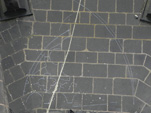Masons at Work
MIchael Davis
Mount Holyoke College

MIchael Davis
Mount Holyoke College
Plans and Revisions: The Terrace Drawings at the Cathedral of Clermont-Ferrand
Around 1260, Jean Deschamps, master mason of Notre-Dame at Clermont-Ferrand, etched two window designs into the stone pavement laid atop the ambulatory and radiating chapels of the new cathedral choir. For the next 250 years, his successors continued to use this terrace, pressed into service because of the constricted building site, as a drawing surface for components of the Gothic structure. Constituting the most extensive surviving medieval corpus of 1:1 scale designs, the Clermont-Ferrand choir and nave terraces picture flying buttresses, tracery patterns, the archivolts and gables of the transept portals, as well as their rose windows.
Exclusively two-dimensional, these drawings fulfilled a variety of pragmatic purposes, for example setting out guide lines for the location of structural elements such as buttress piers or the curve of flyer arcs that could be used for the production of templates. They also witness the master mason “working things out,” correcting dimensions in successive versions to insure precise facture. The beautifully finished and detailed representation of the south transept portal may have aimed to show the bishop his magnificent entrance. The terrace drawings also reveal dramatic moments of critical evaluation and change during the construction process. Those two windows designed by Jean Deschamps were never built; instead they were revised and replaced by a new pattern, also created by Deschamps, that achieved a higher degree of visual harmony and was better tailored to the dimensions of the monumental figures of the stained glass program. The tracery drawings also include fragments of an underlying geometric matrix that points to their origins in a small-scale sketch that was then translated to full-scale on the terrace.
The Clermont-Ferrand terrace drawings continue the technique of full-scale drawing that had been a standard design strategy since ancient Greece and Rome, now joined to an expanded graphic arsenal. At Clermont-Ferrand at the same time that masons cut their designs into the terrace stones, carpenters drew small-scale sketches for a new roof and a spectacular elevation of a flamboyant west façade was inked onto parchment in the hope of attracting royal patronage. The terrace plans admit us into the workshop where thought and labor coalesced. As the sinopia for the image of the completed church, they document the drafts and decisions, the fluid dialogue between conception and execution that animated late medieval building practice.
Exclusively two-dimensional, these drawings fulfilled a variety of pragmatic purposes, for example setting out guide lines for the location of structural elements such as buttress piers or the curve of flyer arcs that could be used for the production of templates. They also witness the master mason “working things out,” correcting dimensions in successive versions to insure precise facture. The beautifully finished and detailed representation of the south transept portal may have aimed to show the bishop his magnificent entrance. The terrace drawings also reveal dramatic moments of critical evaluation and change during the construction process. Those two windows designed by Jean Deschamps were never built; instead they were revised and replaced by a new pattern, also created by Deschamps, that achieved a higher degree of visual harmony and was better tailored to the dimensions of the monumental figures of the stained glass program. The tracery drawings also include fragments of an underlying geometric matrix that points to their origins in a small-scale sketch that was then translated to full-scale on the terrace.
The Clermont-Ferrand terrace drawings continue the technique of full-scale drawing that had been a standard design strategy since ancient Greece and Rome, now joined to an expanded graphic arsenal. At Clermont-Ferrand at the same time that masons cut their designs into the terrace stones, carpenters drew small-scale sketches for a new roof and a spectacular elevation of a flamboyant west façade was inked onto parchment in the hope of attracting royal patronage. The terrace plans admit us into the workshop where thought and labor coalesced. As the sinopia for the image of the completed church, they document the drafts and decisions, the fluid dialogue between conception and execution that animated late medieval building practice.


